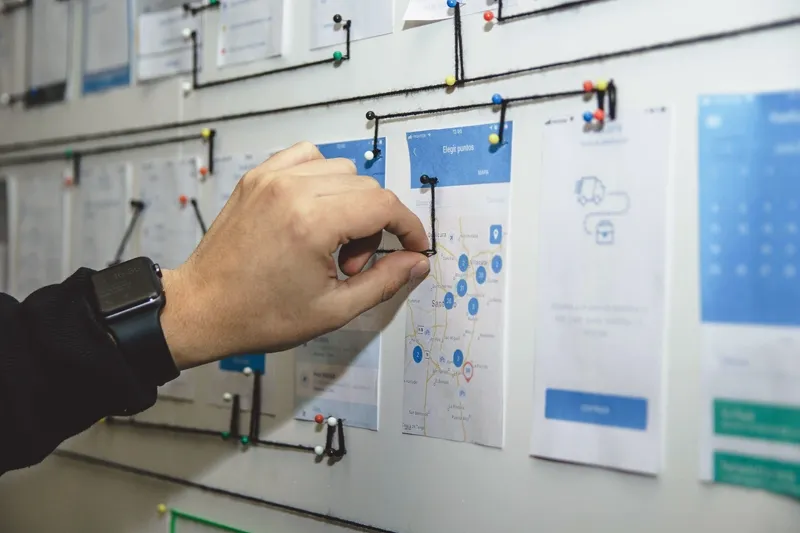How to Define Training Goals for your Employees

When it comes to writing about Learning and Development and training goals in the workplace, it’s rather easy to speak hypothetically and offer some guidance and those little nuggets of wisdom on how to, for example, motivate employees to attend training or why you should include gamification in your next training program.
When you’re behind the laptop writing an article, you’re somewhat removed from the situation: writing and then actually putting what’s written into practice are very, VERY different things.
So, for this post, we’ve decided to compile a comprehensive (and practical) list on training goals, KPIs, and types of training programs you should be considering and tracking in order to create a training program that demonstrates value and ROI.
With numbers, metrics, KPIs, and training goals, it becomes much easier to see the value training is bringing to your organization. I think it goes without saying that in a customer-centric world that requires skilled employees to optimize every process, training is the most important investment a company can make. Nonetheless, it is necessary for companies to prove the ROI of their training activities.
It’s not enough to just organize training activities. It is also important to show what training activities have proven to be successful based on the training goals and objectives set during the design phase. And if training just ain’t showing that ROI, then you can sure as heck bet on your bottom dollar that the training will be scrapped.
Before such drastic measures are taken, however, let’s consider all the positives of L&D in the workplace and focus on how to define training goals and KPIs that count while also focusing on your greatest asset: employees.

Table of Contents
First Things First: Training Goals and the Training Needs Analysis
The very first step of a training management cycle, before training even begins, is to identify what the training needs are and what gaps exists in employee job performance. And the best way to do this is by conducting a Training Needs Analysis (TNA). For a quick definition: A TNA is the process of identifying and assessing the training and development needs of employees within a company so that they can perform their job effectively.
(Random aside, but TNA reminds me of DNA. And DNA is our genetic blueprint. So consider your TNA to be your organization’s blueprint, which will, if we go with the metaphor, help your organization develop and grow over time with the right amount of investment). You can also define your training needs like this:

There are different types of TNA, each with their own value, importance, and relevance. A TNA can be conducted by a facilitator at any time, but they’re best done after hiring, before performance reviews, when performance improvement is needed, for career development, or when there is a need to make changes to employees’ jobs. Deciding on which one(s) to implement depends on what suits the company best at any given moment.
Organizational
Involves the analysis of the business’ needs, goals, and strategies, or reasons why the training is needed. A helpful question to ask here: What is the organization trying to accomplish (overall)?
Person Analysis
This relates to an analysis concerning potential participants and instructors. I.e. who will receive the training? What is their learning style? Who will conduct the training? What changes have occurred, such as software, policies, or procedures, that necessitates this training?
Task analysis
This is the analysis of the work and the requirements needed to perform a job effectively (skills and duties).
Performance analysis
Are the employees performing at a high and desirable standard? Can training help improve performance?
Content Analysis
This involves an analysis of laws, policies, and documents used on the job. Here, it is important to make sure that the training will not compromise on any regulations or job requirements.
Training Suitability Analysis
Is training actually the way forward and will it provide a solution to the problems the organization is currently facing? Will it give a ROI? Training may not always be the most appropriate solution to a problem, so this is how a Training Suitability Analysis can help. The last thing you want is to channel resources into a training program that doesn’t actually solve anything.
Cost-Benefit Analysis
An analysis of, wait, you guessed it, the ROI of training. Effective training means that the return value to the organization is greater than the cost of implementing and following through with training.
A TNA basically asks and answers the 5Ws. I think you know them. But I’ll write them anyway because who doesn’t LOVE reading a long article …
- WHY conduct the training? Will the benefits of the training outweigh the problems being caused by the gap in performance? Will this training guarantee the organization a decent ROI?
- WHO is involved in training?
- HOW can the gap in job performance be fixed?
- WHAT training will be most beneficial to employees? What is missing from existing training? What is needed but not readily available? What training goals need to be set?
- WHEN will training occur? Here, it’s important to consider any logistic constraints, such as where the training will be held, can employees attend, will commuting costs etc. be too expensive, will employees have time.
The key advantages of a TNA are to ensure that workplace training is targeted and effective. But more than this, TNAs:
- Help L&D professionals, HR, and employees pinpoint specific training needs and goals or what gaps exist between current and desired performance.
- Help identify if the gaps in performance can actually be improved or corrected by training.
- Help define the specific training goals and objectives of training (KPIs and metrics).
- Solve current problems and enable quick decision-making.
- Help avoid the repetition of past mistakes.
- Put the training resources to good use so that they are used effectively and optimally.
- Avoid training simply for the sake of training.
- Reduce costs associated with wasted training efforts.
- Target the areas of greatest need.
And what’s great about conducting a TNA is that it can be broken down into relatively easy and intuitive steps. For example:
Step 1: Identify problems and needs. What overall goals is the organization working towards?
Step 2: Determine the design of the needs analysis. What target groups need to be trained?
Step 3: Data collection. Conduct interviews, give employees questionnaires and surveys, review documents on existing training, directly observe employees, review relevant literature.
Step 4: Analyze the data.
Step 5: Provide feedback.
Step 5. That’s actually quite a crucial one. Why? …
Because …

Providing Constructive Feedback to Support Training Goals
Feedback is how organizations stay alive. If employees are the heartbeat of the organization, then I guess you can say that feedback is like the defibrillator? Go with me here. Feedback can kickstart the heartbeat and make employees more engaged and productive. But here’s the tricky part: the feedback has to be honest and actionable.
According to psychologist Tessa West, many cultures have the tendency of being very nice to people. So how good is the feedback going to be if people are simply … well … nice?
One of Gallup’s reports on millennials states that only 19% of millennials feel that they receive regular feedback, with only 17% saying that the feedback they actually receive is meaningful. Meaningful feedback is never easy. Sometimes we just don’t want to hear the truth. I mean there’s a reason why we say, ‘just hit me with the truth’. Emphasis on the word hit.
So, the solution to creating an engaged and productive workforce: create a culture of open and honest feedback. Heck, even chuck in a course on how to give and handle feedback ;). And when it comes to giving and receiving feedback, start small and give it broadly, explicitly, and often.
Also. Feedback is absolutely crucial in determining what employees want from training. And this is where our beloved TNA comes in once again. Remember what I wrote about the data collection phase of the TNA? Yes? No? That’s alright. But this phase is probably the most crucial of the TNA because it determines what employees want, when they want it, and how they want it, particularly in terms of professional development goals and skills development goals.
Apart from the usual surveys, questionnaires, one-on-one feedback, and observing employees in the workplace, there are also some great apps in place to help with gathering feedback, which will ultimately help in setting well-defined training goals and training programs. Here are some examples:
Metrics that matter
With this application, you can easily identify areas of wasted investment and focus on tangible results. Feedback from learners helps you discover where there is a need to further tailor training programs to fill new needs that have yet to be covered. Quick feedback means quick changes, which all leads to a quicker and more visible ROI.
Absorb
This LMS lets you report thoroughly on training programs, which enables you to take direct action based on the report. Each report in the app can be tailored to personal preferences and comes with pre-built reports that include, for example, learner activity, learner progress, department progress, learner competencies, and course activity.
TINYPulse Perform
More and more companies are turning to, if not developing their own, mobile apps to give feedback to employees and vice versa. For example, an app called TINYPulse Coach lets employees rate each other on performance and breaks down annual performance reviews into regular check-ins.
Continuous feedback is key because it provides better feedback. It makes data collection and decision-making easier, and the data can be integrated into an organization’s LMS. Regular feedback check-ins are great for fostering employee engagement and reducing employee turnover as ongoing feedback enables employees to adjust their attitudes, habits, and behavior in real time.
How Feedback Affects Training Goals and KPIs
Feedback isn’t just written or verbal. It exists in the form of numbers, metrics, stats, and KPIs too.
When it comes to running a business, leaders need to know what it is working, what isn’t, and what needs to be improved upon. This is no different for Learning and Development professionals.
Aside from the business’ own KPIs, training departments should have their own KPIs too – and having a Learning Management System (LMS) in place can make tracking such KPIs much easier. Also, it comes down to creating QUALITY KPIs that will really show the ROI.
Here are a few metrics that will help you define and measure training goals in your organization:
- Average Test Score: If you’ve implemented a new change to your training program, evaluating the average test score (over a certain time period) will help you determine if the change you’ve implemented has had a positive or negative effect. Also, if you continue evaluating this KPI over time and notice an unexpected or interesting variation, this could indicate that there is a potential problem, such as a new supervisor not performing well.
- Training Completion Percentage Rate: While this may seem like an obvious one, this KPI can help you identify numerous problems. For example, if training is mandatory but there’s less than 100% attendance rate, you can put on your detective-badge and do some ‘snooping’ around to find out why employees aren’t attending compulsory training. This KPI is also a great one for obtaining feedback. Why are only 40% of employees completing a course? Is the course too difficult? Is it irrelevant? Is it difficult to attend? Or do employees just not have the motivation to attend it?
- Departmental Job Competence Rate: This is a good KPI to see the percentage of employees who are fully competent in their job role. If they’re not, then this may highlight the urgent need for some skills development training.
- Class Attendance Rate: Once again, it might seem obvious, but this KPI is helpful for establishing quite a few things. Track the attendance of certain classes over a period of time and see whether the ROI in such a class is worth it. Should this class be cancelled and be replaced by something more relevant? Once again, go incognito and find out why one class, for example, has a higher attendance rate than another. Motivation. Relevance. Boredom. Time and location. Look into all these factors and adjust the training accordingly.
- Average Time to Completion: Measuring the average completion time of training is a key factor in determining ROI. Are employees taking too long to complete training? Is the training actually hindering, instead of enhancing, employee productivity? Again, WHY are employees taking too long to complete the training? It’s all good and well to track your KPIs, but it’s the meaning behind the numbers that’s most important. If you don’t know the why, then you can’t implement the HOW can we improve this KPI.
- Operational Effectiveness Measures: This is a crucial KPI because operational effectiveness refers to the ability to link training objectives to the business’ strategic goals. If your training program needs to address critical gaps in performance, then your KPIs should include operational metrics, which could include deadlines missed or errors in product.
So, at the end of the day, these measurements will show you if:
- The employee is retaining knowledge and applying it effectively.
- The training is benefiting the company as a whole in terms of skills development, productivity, morale, and profitability.
- The training is, to put it plainly, on fire (I was going to use #lit, but let me keep this post on the more professional side).
Finally, if you want to take it a little further, you can break down common training KPIs into three primary tiers to support training goals:
- Measurements, such as measuring average training hours per employee or total cost of training investment as percentage of payroll.
- Supporting metrics, which are used to determine why trends and changes are happening throughout the training process.
- Raw data that is used together with tiers 1 and 2.
When you are able to utilize and manage these KPIs effectively, they can function as an excellent benchmark for you to come up with well-defined, measurable, and valuable training goals.
Now, human capital is undoubtedly an organization’s most important asset. Therefore, HR, along with L&D professionals, need to create initiatives and programs that will increase sales, reduce operating costs, enhance product quality and customer experience, improve employee retention and engagement, and improve leadership.
In order to achieve this, HR first has to align its strategic initiatives to the organization’s goals. But how?
- HR must first talk to executives and the CEO to understand and learn about the following year’s goals and priorities.
- Once these goals have been identified, HR then needs to determine what initiatives and training can help with reaching these goals.
- Each departmental head or the L&D professional should then set SMART training goals that align with the organization’s overall goals (for example: provide training to 80% of the organization’s employees or reduce the ratio of classroom training to elearning by 20%).
- Throughout the year, HR leaders and L&D professionals need to have regular reports and check-ins to assess if goals are being met and what changes need to be implemented if there are problems.
Guess what I’m going to write about next? Hint: 5 letters, one words, all capital letters.
Yes, you’ve got it: SMART goals.

Getting SMART About Training and Training Goals
They always say work smarter, not harder. I mean, how many times have we heard that. Yawn. But let’s break the ‘smarter’ part down a bit into SMART-er.
Setting SMART goals is one of the best ways to tackle training for both L&D professionals and employees. Sometimes, training can be overwhelming, especially when employees don’t have the time for it or they need to learn something either brand new or simply, well, boring.
My tennis coach once told me something that’s stuck with me all these years later: how do you eat an elephant? Well, you certainly can’t eat it in one sitting, so you break it up into tiny little pieces and eat them one by one, over time. Actually, this is a TERRIBLE analogy when I think about it, but you know what I mean (I hope. Also I definitely don’t eat elephants).
So, it’s imperative to set SMART goals, whether you’re the trainer or trainee.
Let’s give a quick example: During the next three months, design a soft-skill course on communication skills that contains a pre-assessment, two hours of online coursework, and one full day of a face-to-face training session.
- Specific: Type of course (soft-skill/ communication) and layout (online and in-person)
- Measurable: Completion of the whole course (can be measured with KPIs) and individual assessments that can be measured
- Achievable/Attainable: Not too demanding
- Relevant: Identified a need for a course on communication
- Time-based: Within three months
If we look at the above SMART goal example, we see that the course on communication skills is relevant to both professional AND personal development. Learning how to communicate effectively is something that can be used in all situations, not just in the workplace.
Let’s Get Personal: Aligning Personal Goals with Training Goals
This has been a running theme on Userlane’s website: It’s about people. So, as much as the organization, executives, HR, and training managers are focused on achieving the organization’s goals, it all really comes down to the employee at the end of the day, doesn’t it? Why? Because as I mentioned at the start of the post, employees are an organization’s greatest asset. They really are the heartbeat of the organization. They’re the jewels in the treasure chest. The pearls in the clam. Ok, I’m done. So as much as you want to align training goals with business objectives, you need to keep your employees in mind – at all times.
According to LinkedIn’s 2018 Workplace Learning Report, talent managers are prioritizing the employee development needs of today, such as ‘how to train for soft skills’, ‘understanding the impact of technology,’ and ‘identifying trends to prevent skill gaps’. Talent managers are also becoming increasingly dependent on elearning/ online learning solutions to keep up with the needs of a multi-cultural, globalized, and multi-generational workforce. Some interesting stats:
- 68% of employees prefer to learn at work
- 58% of employees prefer to learn at their own pace
- 49% of employees prefer to learn at the point of need
Therefore, it’s pretty clear that a one-size-fits-all approach just isn’t going to cut it anymore. (I mean, come on, have you ever tried on clothing that says ‘one-size-fits-all? Ummmm. Dunno about you, but those clothes never, ever fit me.)
Now, we’ve already blogged about how to motivate employees to attend training, so I’m not going talk about that again. But here some pretty important points to remember when it comes to goal-setting for L&D:
- Training must foster both individual and organizational effectiveness.
- Training programs should offer a variety of innovative programs that take into consideration the different learning styles of employees as much as possible.
- Programs should enhance knowledge, develop necessary skills, and enrich both the individual and the organization.
- Organizations must create a culture of learning.
Such culture must take into account the fact that individuals already have their personal goals. Successful companies are those companies that manage to support their employees in achieving their personal goals while aligning personal development with company goals.
Nowadays, thanks to the tutor-like role of talent managers together with employee apps and other direct feedback technology, it’s relatively easy to create specific programs with training goals that perfectly match the expectations of both the company and the employee.
From SMART Goals to Other Training Goals
Apart from setting SMART goals, it’s also important to differentiate between two types of employee training goals, namely: learning goals and performance goals.
So, what’s the difference? Well, performance goals are tied to workplace goals and accomplishments, whereas learning goals are focused on an employee’s desire to improve his/her own skills to be more effective and productive in the workplace.
Performance goals tend to be more short-term based, with learning goals demonstrating more long-term benefits. Here are some reasons why you, as an L&D professional, should encourage employees to set learning goals:
- Increased potential. Setting training goals helps employees enhance their knowledge and skills, which, naturally, only increases what they’ll deliver in the future. So, an investment in skills now means a more profitable and productive future.
- Long-term success. Performance goals are great for the short term. For example: A customer success manager may have a performance goal of 90% customer satisfaction, which is great in the interim, but investing in learning better communication skills and time-management skills is what will pay off in the long run.
- Motivation. Learning goals are more intrinsic in nature, meaning that they tend to give people a stronger sense of empowerment. With performance goals, if the target isn’t reached, it can lead to a sense of failure. So learning goals, which are long-term and achievable, keep the motivation levels up because employees will understand that working towards these long-term learning goals will help them achieve greater performance objectives in the future.
- Career development. Developing and honing skills helps employees remain flexible and more employable. It also helps with promotions and salary increases (those extrinsic motivational factors).
The VARK Model of Learning
Now, once a TNA has been conducted and goals and objectives have been defined, one of the next crucial steps is to determine what kind(s) of training programs/ learning styles to implement for employees.
This is naturally tricky due to different generations and cultures learning differently, and each program will come with its pros and cons. The VARK model of learning styles is something to keep in mind when choosing what programs will work best for your employees. (Fun fact: Vark means pig in Afrikaans. It was one of the first words I learnt in Afrikaans :D).
According to this model, there are four types of learners: Visual, Auditory, Reading, and Kinesthetic. By incorporating materials that appeal to each of these different learning styles, you’ll be on the path to success with your program.
Below are some types of staff training programs you can implement:
- Instructor-led classroom training: This form of training accounts for approximately 42% of a company’s training hours. It’s a traditional approach that mimics what most of us are familiar with: A typical school or college classroom experience. It allows for personal interaction (if the class isn’t too big) between the trainer and other employees, and trainees will be more familiar with this type of learning.
- Interactive methods: Think classroom learning 2.0. This type of training offers classroom-style lectures but incorporates interactive group activities, case study reviews, role playing, quizzes, and presentations.
- Hands-on training: Forget the theoretical, this is all about diving right in by allowing employees to get their hands on whatever they’re learning. Seattle Genetics in the US has this type of training down to an art: they offer unique one-year fellowships to their employees, which immerses them in practical training.
- eLearning: Training that’s hosted online via a website or app. I don’t think I need to delve into the benefits of it here. It’s a super popular choice for many companies, with over 77% of American companies offering some type of online training.
- Video training: Interesting stats: 96% of businesses say video supports them in training employees better and faster. No surprises there, though, right?! People are stimulated visually, so videos are easily entertaining, engaging, and interactive. I mean who DOESN’T love watching YouTube videos of conspiracy theories surrounding the Bermuda triangle? Just me? Oh. Ok.
- Coaching and mentoring: Implementing a coaching or mentoring program can be a great way to supplement more rigid employee training methods. Having a coach or mentor builds relationships and helps with goal-setting. Employees will always have someone on hand to check-in with them and see how they’re progressing. Boeing is an awesome example of a company offering a successful mentorship program by offering interns and new hires the opportunity to learn from well-established execs who can help them set career goals and develop important leadership goals.

Companies That Are Kicking Some Serious L&D Butt with Great Training Programs
It’s also good to get a little inspiration from others. Here are a few companies that go above and beyond with their training efforts.
Ok, not (yet) a well-known company and relatively small in comparison to the giants with only 800 employees, but Seattle Genetics makes Monster’s Top 10 list of companies offering awesome training and development programs. The company offers tuition reimbursement, onsite training courses for job-related skills development, access to conferences and seminars, and supports continuing education.
With close to 20,000 employees worldwide, SAS has an impressive list of L&D initiatives, such as leadership programs, career mentoring, a career resources center, and a SAS Academics program for sales and technical enablement (in-class and practical training) for career-entry graduates.
Shannon Heath, senior communications specialist at SAS says, ‘Knowledge workers never want to be stagnant … So SAS provides opportunities for growth to keep our employees challenged, motivated and engaged.’
Amazon
Perhaps no surprises here. What defines Amazon’s training program is that it offers a month-long and hands-on training and leadership program prior to hire. The company also pays almost full tuition for employees to take courses in fields that are in demand and has something known as a ‘Virtual Contact Center’ that trains employees to work from home, which is great for an increasingly globalized and remote workforce.
Perhaps also not very well-known, but CultureAmp offers each employee access to a professional coach through the Coaching for Everyone program. At 6, 12, and 24 months, employees can choose to either focus on personal or professional goals, and coaches help employees with where they’re at currently and where they’d like to be in the future. They then help with setting a strategy to help them achieve their goals.
This company encourages its employees to attend important events that will help them keep ahead of the game in their respective fields. Employees are also given a professional development budget to use throughout the year. Employees get to work closely with their managers and department heads to decide which programs are best suited to their development.
I could give more examples, but I’m kinda going a little bit over with the word-limit, aren’t I?!
Now for a quick little exercise. What was your key takeaway from what each company listed above provides in terms of L&D? No peeking. Ok, you looked, didn’t you. That’s okay. You’re busy.
- Paid tuition
- Pre-training
- Access to resources
- Professional coach for goal-setting
- Professional budget
And the important thing about each initiative is that they are linked to both intrinsic and extrinsic motivational factors.
Always keep in mind that your company is only as good as the people you hire. In order to attract the best of the best, it’s crucial that you offer a great benefits package — ideally, one that includes a health and wellness program. Four out of five employees say that getting a new benefit, like professional development, is more important to them than a salary. Show your employees that you care about their wellbeing — and combat costly turnover — by implementing some of the benefits in the infographic below.
Source: turbo.intuit.com (please include attribution to this graphic)
Setting Training Goals: ROI, the Bottom Line, and the Human Experience
It’s not uncommon for business to cut training programs when the going gets tough. But consider what training actually does for the company in both the short- and long-term.
- Well-trained employees are good for a company’s brand and reputation. They will also be able to speak knowledgeably about the industry.
- Well-trained employees are also engaged employees. And engaged employees will want to do more for their customers.
- Engaged employees will also have higher levels of productivity – stats indicate that highly-engaged employees are 38% more likely to have more-than-average productivity.
- Engaged employees also bring new ideas to the table. Why? Because if they’re continuously learning new skills, they’ll be excited to share what they’ve learnt with the team. More ideas, more enthusiasm, more productivity – what could be greater for increasing your bottom line?!
To create training programs that add value, create a greater ROI, appeal to both personal and professional employee goals, and increase the bottom-line, you need to consider and incorporate what’s been discussed above. Start off with the TNA, get leaders involved, obtain feedback from employees and, based on this, define personal and professional goals that align with the companies’ objectives.
From here, choose a learning program best suited to the employees needs and closely monitor the KPIs. Doing this will guarantee success and create a kick-ass learning culture in your organization.
And one more thing: Invest in others. If your company can’t afford to invest in an L&D program, then send them to various events and conferences where learning happens. There’s always opportunity for learning, you just need to find them.
Full Support in Setting Training Goals and Designing Training Programs
So, how does what I’ve written above all come together to support you in setting training goals and training programs that make sense and add great ROI?
Well, I’ve given really powerful and viable tools that will help you focus on what’s needed most and what will benefit both employees and the organization the most.
The information I’ve provided above is to help you kickstart L&D initiatives that are highly focused, relevant, results-driven, realistic, and trackable. Essentially, everything listed here is to help you set SMART training goals.
Let’s go with the medical metaphor one more time:
The employees are the heartbeat of the organization – and how do you keep this heartbeat going? In human terms, to stay alive, we need the basic necessities, like food, water, and oxygen. Think of staff training programs as one of the basic necessities that keep the heartbeat going.
Developing really good and powerful training goals won’t happen overnight – it’s a journey. And the information given above is to help you along this journey. If your destination is the establishment and achievement of relevant, results-driven, inspiring SMART training goals, then a TNA, setting specific KPIs and metrics to track, and understanding and valuing different learning styles when implementing training programs are all pit-stops along this journey.
The TNA is your first pit-stop. Without it, you won’t be able to fully identify what the training needs of the organization are. The TNA is tied to feedback, and without valuable, real, and honest feedback, you won’t be able to fully cater to the needs, desires, and goals of employees and the organization. From the TNA and feedback, you can start thinking about SMART goals and what performance and learning goals the organization and employees want to achieve (both short- and long- term). From here, it’s time to start thinking about what types of training programs you want to create. And once you’ve implemented your training programs, you can start tracking your KPIs. So, moving logically from pit-stop to pit-stop will get you to your destination of reaching and achieving training goals efficiently and successfully.
By implementing all of these tools, you’ll have all the direction you need to achieve training goals that align with both employees and the organization.
Do you feel like you’re ready to update your training goals to match the demands of the digital era? Take our digital transformation quiz and put your knowledge to the test!


